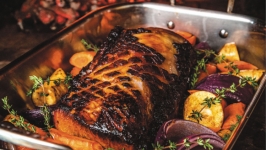Preparation
2 pork tenderloins
1 cup garlic confit (see recipe from intro)
1 tablespoon sage, lightly chopped
1 tablespoon thyme, lightly chopped
1½ tablespoons tarragon, lightly chopped
½ teaspoon black pepper
zest of one lemon
4 cups garlic oil (see recipe from intro)
salt to taste
In a small bowl, stir together the garlic confit, sage, thyme, tarragon, black pepper and lemon. Reserve.
Lay the pork tenderloins on a clean cutting board. To remove the silver-skin, run a sharp knife along the underside and discard. Lay both of the tenderloins so the heads (thickest end) are at the top end of the board and the tails (thinnest end) are closest to you.
Starting about an inch from the top of the loin, a half inch in from the right side (if you are right-handed), cut a slit 3/4 of the way through the pork, stopping an inch from the bottom. Open up the slit and cut a pocket into the loin, making sure that you don’t cut through all the way.
Fill each of the loins with the garlic and herb mixture. Using kitchen string, tie the loins, spacing the strings no more than an inch apart. The garlic mixture will want to push out as you tighten the string, but just push it back. Some of the garlic will remain sticking out — that’s okay. Season the pork lightly with salt.
Place a dutch oven or pot onto the stovetop and add the garlic oil. Turn the heat to medium-low. Place both of the loins into the oil. The oil should just cover the pork, if not, top up with canola or cooking oil. Cook the loins to 130F to 135F* (medium-rare). Remove the loins. To brown the loins, place in a hot skillet with a tablespoon of oil and sear on both sides. Place onto a plate lined with paper towel and allow them to rest for about five minutes.
Once rested, cut off all of the string and cut into thick slices, then sprinkle with a touch of finishing salt and fresh-cracked pepper. After resting, you can also place the loins into the refrigerator and once cold, they can be cut into thinner slices for a charcuterie board.
*Cooking time will depend on the temperature of the oil, but we feel the best results come from oil at a very low simmer. This could take 45 to 60 minutes (or longer) for the pork to reach an internal temperature of 130F. Also, a meat thermometer or probe is the best way to determine temperature. If you aren’t using one, once you start to see a little blood come from the top of the meat, the meat can be removed and will rest to medium (140F to 150F).








